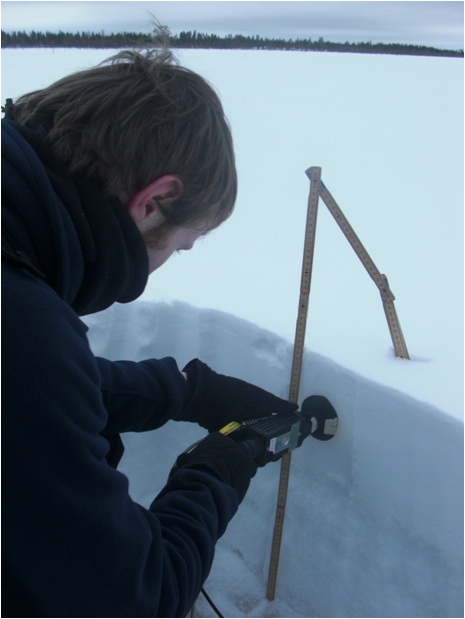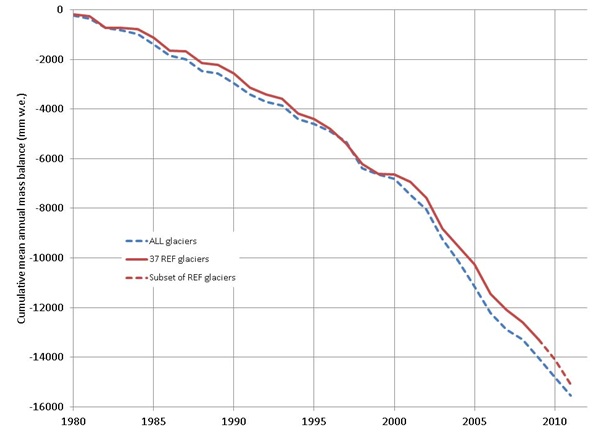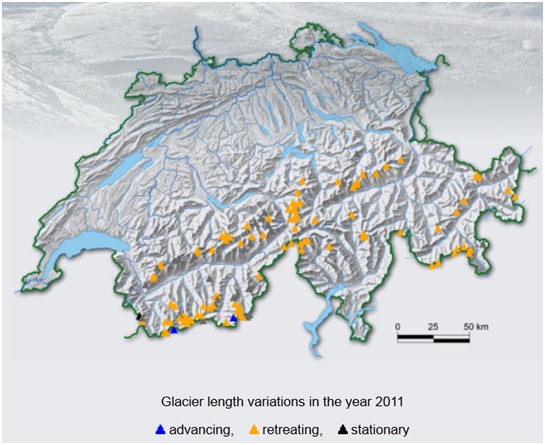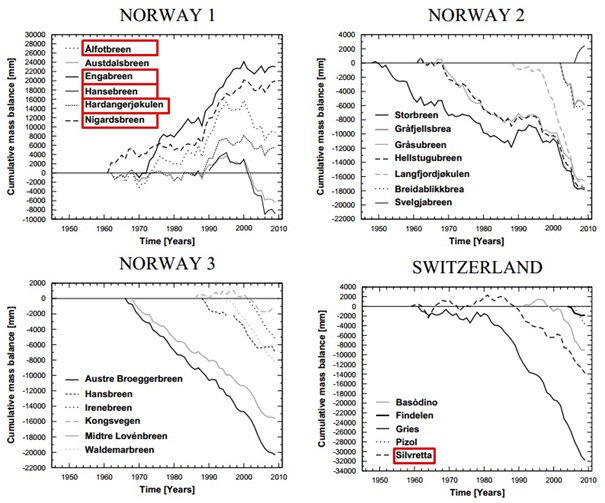
Figure 1 Your author taking measurements in a snowpit in Finland. Snowpits are used to get details about the snow properties, including on glaciers and for predicting avalanches.
Newly released measurements of 100 world glaciers show that 2011 saw the third fastest thinning on record, an average of 80 centimetres (31 inches). This report adds detail to the 500 billion tons a year of ice loss that was seen by the GRACE satellites from 2003-2010, of which 150 billion tons was mountain glacier retreat (Jacob et al, 2012).
We'll get on to the blog & media obsession with growing glaciers later, but first a quick look at the new measurements released by the World Glacier Monitoring Service. They've been looking at glaciers in great detail by getting boots-on-the-ground, scientists who force stakes into the ice and dig pits in the snow for good old-fashioned measurements. As well as being more accurate, these measurements started before satellites even existed (Zemp et al, 2009).

Figure 1 Your author taking measurements in a snowpit in Finland. Snowpits are used to get details about the snow properties, including on glaciers and for predicting avalanches.
The preliminary measurements show that for this worldwide selection of glaciers, 2011's loss was only beaten by 2003 (when a European heatwave punished Alpine glaciers) and 2006. The change is reported in 'mm water equivalent', which is how deep the water would be if all of the lost ice were melted in place on top of the glacier. Every year since 1984 has seen overall melt, for a total of about 15 metres (49 feet). Last year also confirmed the death of the 18,000 year old Chacaltaya glacier in Bolivia.

Figure 2 Change in total glacier thickness in equivalent water depth for the glaciers measured in detail for the World Glacier Monitoring Service, from 1980-2011.
Most, but not all glaciers are shrinking (the last update found almost 90% were losing weight) and satellites show the overall loss is now 150 billion tons of ice a year. Despite these facts, we regularly see media articles claiming that glaciers are growing; what's going on?
Cherry-picking is where an author carefully selects only data that agree with them to mislead readers, and you can learn to spot this in blogs and newspapers.
It's very easy to be fooled by the simplest trick: it's where we're shown a handful of stable or growing glaciers as examples that they're fine. There are tens of thousands of glaciers in the world and most measured ones are shrinking. But local weather means that in some years a small number will grow: the Swiss Glacier Monitoring Network reported that Mont Durand glacier grew by 23 metres length in 2011, and the misleading writer will look here. They will forget to report that for that one growing glacier, 92 others in Switzerland shrank, including the Roseg glacier which retreated backwards a staggering 1,305 metres (most retreated by tens of metres). They have turned a story about 92 shrinking glaciers and 1 growing glacier into a story about global warming not being true.

Figure 3 Map of 2011 glacier change in Switzerland(REF). Blue ones are getting longer, yellow ones shorter. There are two blue triangles, but one of those increase (+0.4 metres) is so small that the measurements aren't precise enough to confirm it, so only one is listed as definitely growing.
They make the story sound better by whisking you around the world with different examples, but without saying that for every stable glacier they talk about, there are lots more that are shrinking.
Sound like a ridiculous and deceitful trick? Yes, it does, but it's been tried here and here and here and here and here and elsewhere.
There are other tricks too, and it's much harder to realise that they're being used. Your only defence is to ask yourself where the measurements come from and if you're getting the full details.
As well as just looking at a handful of the glaciers, sometimes the misleading author will only give you certain times as well. For example, in 2011 the US saw slight thickening on average. This might get coverage, but the fact that they're still thinner than 5 years ago because of previous losses will be hidden. Norwegian and Swedish glaciers grew in the 1990s due to changing weather patterns, now they have stopped growing (Nesje et al, 2008, Engelhardt et al, 2010) but some reporters are stuck in the '90s.
The hardest trick to spot is where someone says something that isn't true. One blog promises that an ice age is on the way, but to avoid the fact that glaciers are actually shrinking they combine cherry picking with wrong or out-of-date 'facts' of their own.
Overall, measurements show that Greenland is now losing hundreds of billions of tons of ice a year (Shepherd et al, 2013). Warming has meant that the frigid interior has thickened because of heavier snowfall as the warmer air holds more moisture (Johannessen et al, 2005), but that the edges of the ice sheet have been melting so quickly they overwhelm this (Rignot et al, 2008). The real story is that Greenland is losing weight, but this blog isn't alone in saying the opposite.
Various other glaciers that are listed as 'growing' have been shrinking for years: including Norwegian ones like Briksdalsbreen (Nesje et al, 2008), Alfotsbreen (thinner by 8.8 m from 2001-10) and Hansebreen (thinner by 14 m over 2001-10). Engabreen has stablised in thickness, but has been losing area (Kjollmoen et al, 2011)
One of the glaciers listed, Silvretta glacier in Switzerland, has lost length every year since 1984, and has also thinned by 14 metres since then. But it had two years in which it lost area, but thickened slightly, and this is enough for blogs to say that it's growing.

Figure 4 Change in glacier thicknesses measured in Norway and Switzerland since the 1950s. A red box is around the glaciers that were listed as 'growing' by climate skeptics, although all of them are now either stable or shrinking. All of the other glaciers, which are shrinking, were ignored. These 6 were chosen for presentation, but the other 18 shrinking ones were ignored.
The big picture is that most glaciers are shrinking. A small fraction are growing, but for every measured growing glacier there are 9 shrinking ones. 2011 saw the third fastest retreat, and we know that overall glaciers are losing about 150 billion tons of ice a year because of satellite measurements. Stories about growing glaciers are popular on some blogs and newspapers, but they rely on hiding or ignoring 90% of the evidence.
Posted by MarkR on Friday, 1 February, 2013
 |
The Skeptical Science website by Skeptical Science is licensed under a Creative Commons Attribution 3.0 Unported License. |